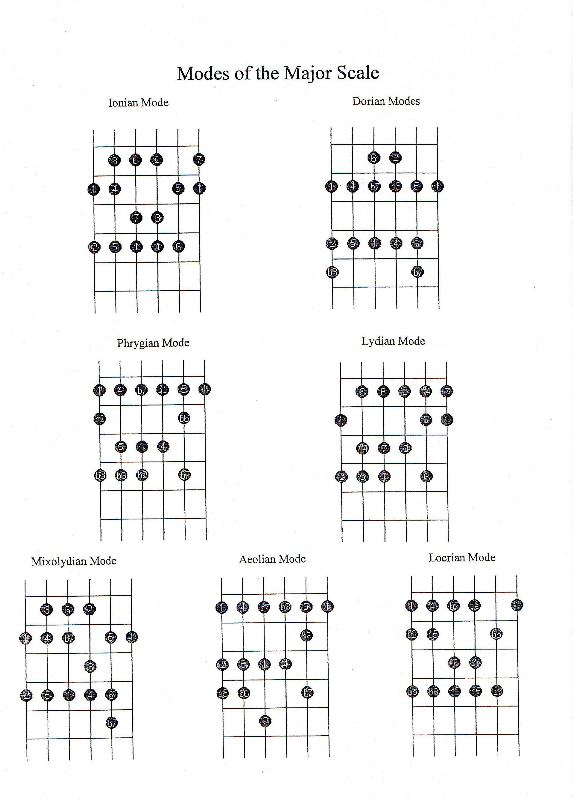Learn Guitar Modes
Guitar Modes that form a scale called 'the modes' (or with too limited a suggestion, the church modes or the ecclesiastical modes). dominated European music for 1100 years { sayAD 400 to AD 1500 }, strongly influenced composers for another hundred years, and has since reappeared sometimes in the work of some composers, especially in the present century. Throughout that total period of 1500 years the plainsong of the church which is entirely modal had continued to accustom the ears of fresh generations to the melodic effect of the modes.
The available material of music at the period when the modes became accepted was that which we could nowadays conveniently describe as represented by the white keys of the piano or organ, whose notes constitute { with slight differences of tuning } the scale which in the 4th C.B.C. Pythagoras and the greek thinkers of his period had worked out scientifically. In the 2nd century AD the greeks were using this scale in seven different ways, Greek influence was strong in the early christian church and when the famous bishop of milan St. Ambrose AD 340 - AD 397 undertook to set in order the music of the church he accepted the greek scale but laid it out in four Guitar modes {i.e manners} of using its notes. It has been ususaly accepted that pope gregory {St Gregory the Great AD540-AD604) elaborated the Ambrosian system, adding 4 more Guitar modes. To these 8 modes 4 more were later added making 12.
Guitar Modes Video Lesson 1.
Guitar Modes Video Lesson 2.

The Modes-Major Scale produces:
I----------- Ionian
II---------- Dorian
III--------- Phrygian
IV---------- Lydian
V----------- Mixolydian
VI---------- Aeolian
VII--------- Locrian
Melodic Minor scale produces:
I------------Melodic Minor
II-----------Dorian b2
III----------Lydian Augmented
IV----------Lydian Dominant
V-----------Hindu
VI----------Locrian (neutral) 2nd
VII---------Super Locrian
Harmonic Minor scale produces:
I-----------Harmonic Minor
II----------Locrian (Neutral) 6th
III---------Ionian #5
IV---------Dorian #4
V----------Phrygian (neutral) 3rd
VI---------Lydian #2
VII--------Alt bb7
Harmonic Major produces:
I----------Harmonic Major
II---------Dorian b5
III--------Phrygian b4
IV--------Lydian b3
V---------Dominant b2
VI--------Lydian Augmented #3
VII-------Locrian bb7
Hungarian Minor produces:
I-----------Hungarian minor
II----------Oriental
III---------Ionian Augmented #2
IV---------Locrian bb3 bb7
V----------Double Harmonic
VI---------Lydian #6 #2
VII--------Alt (neutral) 5th bb7
Hungarian Major produces:
I-----------Hungarian Major
II----------Alt bb6 bb7
III---------Locrian (neutral) 2 7
IV---------Alt (neutral) 6
V----------Melodic augmented
VI---------Dorian b2 #4
VII--------Lydian Augmented #3
Neapolitan Minor:
I----------Neapolitan minor
II---------Lydian #6
III--------Dominant augmented
IV---------Hungarian Gypsy
V---------Locrian (neutral) 3
VI--------Ionian #2
VII-------Alt bb3 bb7
Neapolitan Major:
I---------Neapolitan Major
II--------Lydian Augmented #6
III-------Lydian Dominant Augmented
IV-------Lydian Minor
V--------Major Locrian
VI-------Alt (neutral) 2nd
VII------ Alt bb3
http://www.cyberfret.com/theory/modes/101/
index.php
http://www.jazzguitar.be/modi.html
http://guitarsecrets.com/guitar_modes.htm
http://www.myguitarsolo.com/sc_major.JPG
http://www.guitarnoise.com/article.php?id=337
http://www.zentao.com/guitar/modes/
Guitar modes - Ionian Dorian Phrygian Lydian Mixolydian Aeolian Locrian
